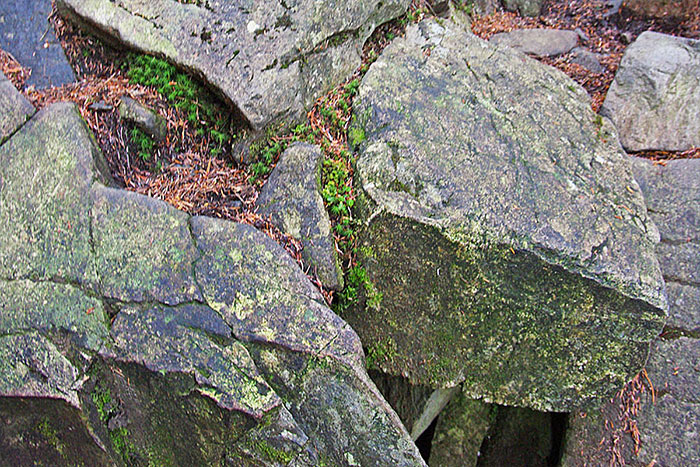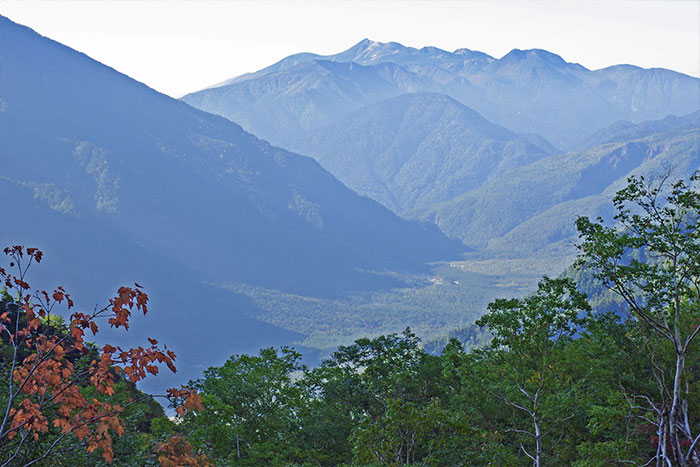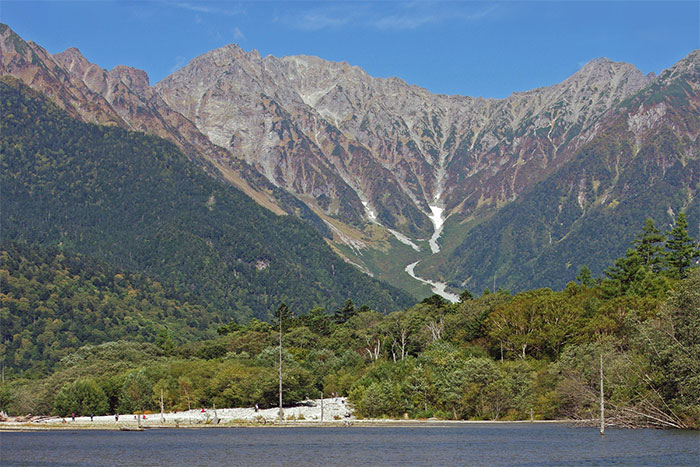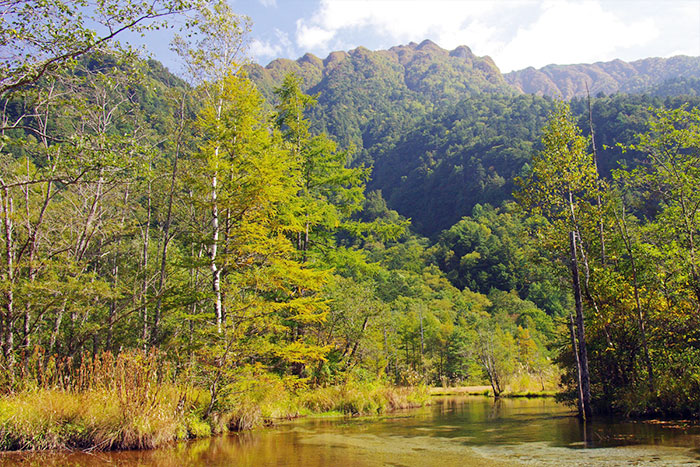The Hiking Route for Dakesawa Autumn Leaves Viewing
Taisho-ike ~ Kami-kochi ~ Dakesawa-koya Mountain Hut ~ Kami-kochi (Beginner)
Compared to Karasawa route, there are fewer panoramic views and types of trees that change color in the fall, however, it is a much shorter and quieter course that not many hikers know yet.
●Hiking Data
Schedule: One day
Walking hours: 5 hours 20 minutes
(Up: 3 hours 20 minutes Down 2 hours)
Walking distance: 11.5 km
Variance in elevation: 660 m
Taisho-ike
Elevation 1,500m
↓ 20 minutes
Tashiro-ike
Elevation 1,500m
↓ 30 minutes
Kami-kochi
Elevation 1,505m
↓ 1 hour 20 minutes
Kazeana
Elevation 1,735m
↓ 1 hour 10 minutes
Dakesawa-koya Mountain Hut
Elevation 2,161m
↓ 2 hours
Kami-kochi
Elevation 1,505m
Route Guide
This route takes you to Dakezawa-koya Mountain hut on the shortest trail from Kami-kochi to Mt. Hotaka-dake, the Jutaro-shindo Trail. Compared to the Karasawa route, it is only about 1/3 of the distance. The variance in elevation is about 80% of the Karasawa route, therefore, it takes about 4 hours 30 minutes, half that of Karasawa route. The route can be enjoyed as a day hike from Kami-kochi. Since this route covers a long trail through forests, it is recommended that you start from Taisho-ike and visit Tashiro-ike, known for the autumn colored grand level grasses.
When you get off the bus shuttle at Taisho-ike, Taisho-ike is reached shortly. The Hotaka Mountains such as Mt. Oku-hotaka-dake can be viewed over the clear blue water surface of Taisho-ike. The white v-shaped spot in the middle of those mountains is Dakesawa. Dakesawa-koya Mountain hut stands in the middle of Dakesawa. This route is a round trip to the hut.
Hike up north along the wide lake shore and proceed to Kami-kochi nature research path. It enters a coniferous forest. Tashiro-ike is reached when trees become scattered. Above the pond, the stone peak, Mt. Kasumi-zawa dake stands and on the north side, Mt. Hotaka-dake also peaks out.
Hike up north on the nature research path and cross Tashiro bridge to the other side of the shore, then proceed to Kappa bridge after passing Weston monument. Most of the hikers heading to Karasawa or Mt. Yariga-take walk on the east side of the bank, however, if you are heading to Dake-sawa, you must proceed to the west side of the bank.
Just ahead of small Dakesawa shitsugen, the trail splits with the Dakesawa route going left while the trail to Myojin goes straight. Cross a logging road and enter a trail covered by evergreen coniferous trees such as Abies Veitchii. It does not have an open view but it is a relaxing trail.
A kazawana is reached when the slope grows steep and the trail ascends in a zigzag pattern. A kazawana is a hole among rocks that have piled up and where a cold wind blows through. The cold wind feels nice and cool in the summer and it is referred to as natural air conditioniing. Ascend higher and cross Mae-myoujin-zawa. A view of Mt. Norikura-dake above the valley of Kami-kochi can be seen when looking back. Around this point, you have already ascended about 300 m from Kami-kochi and this already covers half of the total variance in elevation.
The trail enters the forests again. As you descend, evergreen coniferous forest changes into a deciduous broad-leaved trees forest and the trees become scattered. When the graveled Dakesawa is reached, the view becomes wider and enjoyable. Ascend along a wide graveled stream till Dakesawa-koya Mountain hut, your goal. Enjoy a view of the rocky walls of the Hodaka Mountains surrounding Dakesawa and the autumn leaves.
To descend, hike down the same trail used for ascending. Jutaro Shindo trail ahead of the hut is known as one of the steep slopes within the North Japan Alps and is a route for experts with continuous rocky zones. Make sure that you do not enter the trail by accident.
The best season for autumn leaves nearby Dakesawa-koya Mountain hut is early October. The season for Taisho-ike ~ Kami-kochi is from middle to late October. The autumn coloring of ground level grasses at Tashiro-ike peaks in early October. The peak of autumn leaves changes from year to year so make sure that you check the latest local information before you visit.







